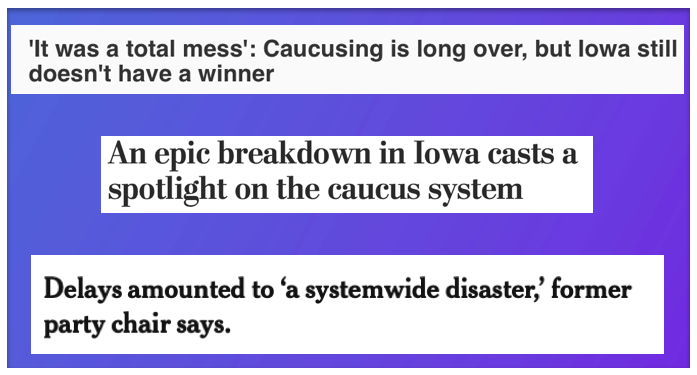Hey Iowa! No pressure, but the whole world is watching. And unfortunately, the Iowa Democratic Party’s caucus blunder and (lack of) crisis communications have left many of us confused, disappointed, and frustrated at the kick-off of our presidential election season.
Many of the “morning after” conversations have focused on the decision by Iowa’s Democratic Party to use new technology at such a critically important event. I believe the greater miss by the Party was how poorly they communicated the biggest political blunder thus far this year.
We all make mistakes. It happens. But when a plan is derailed, there are a few steps that allow people to feel as if communications—and leadership—are in place.
Provide talking points to your frontline communicators as the process unfolds. As I watched the situation unfold on CNN and via my Twitter feed, I felt anxious for the precinct chairs and volunteers who were unsure of how to share their caucus results and simultaneously had attendees and members of the media asking for updates on a process beyond their control. I would never suggest making volunteers and chairs the spokespeople for the situation, but instead advocate for arming them with language to address concern before it becomes panic or anger. Similarly, there should have been prewritten talking points that could have been sent if the process had gone smoothly. It would have allowed the chairs to thank the participants and share a cohesive and rallying message among Democrats in advance of the New Hampshire primary.
Share information directly with those most immediately impacted. Based on media reports, the Democratic candidates and their teams didn’t receive adequate information post caucus. This allowed them to use whatever information they had to share their preferred narrative. Not surprisingly, multiple winners were self-named and the confusion and frustration across the state and nation grew. Once the results are released, the Iowa Democratic Party is going to have to chase media accounts of the “winners.”
Define your distribution channels and recruit those who can amplify your message in advance. Part of the confusion around the status of the caucus results was that there didn’t seem to be a cohesive message from the Iowa Democratic Party nor an obvious place for media and the public to go for updates. Ensure nobody has a question about where you post, how to follow your news and where and when to expect updates. And, use the power of social influencers who align with your mission and goals to share your news more broadly and quickly. Include them in your communications planning and agree upon their supporting role and assistance in advance.
And finally, the most important communications tip is to own your mistake and share learnings from it. That principle applies today as the situation is unfolding and in the coming months as the situation is dissected and other states begin their election season events. Serving as a resource to others allows you to transition from a what-not-to-do example to a what-to-do instructor. Even the biggest of fails can become a win—or at least neutralized—by apologizing, taking responsibility, providing lessons learned and communicating it broadly.
